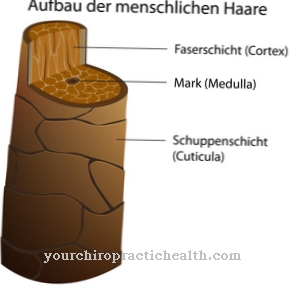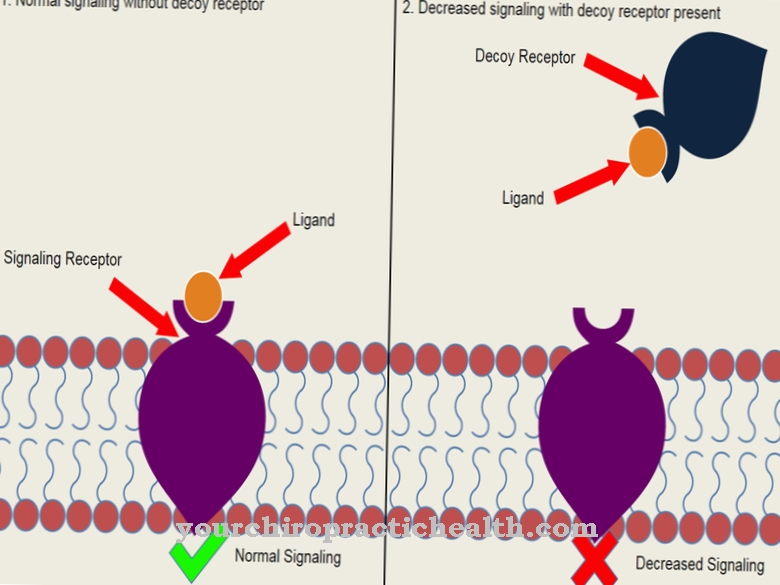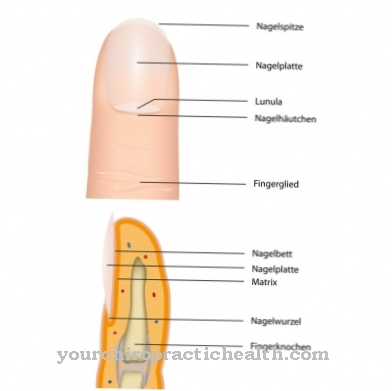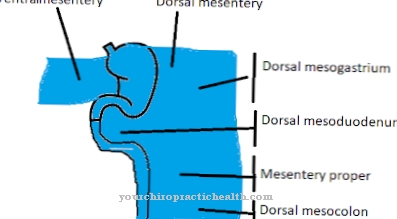Of the Globus pallidus, that too Pallidum called, is located in the central area of the brain and is responsible for activating all movement sequences in the human body. From this function it is assigned to the basal ganglia (basal nuclei), which belong to the cerebrum and are located below the cerebral cortex.
What is the globus pallidus?
Historically, the pallidum is part of the diencephalon. Its German name, translated from Latin, is "pale sphere". This name refers to the microscopically almost colorless appearance of the globus pallidus, which is composed of many large and noticeably pigment-poor nerve cells.
It is surrounded in the brain by the putamen, the so-called shell body, and separated from it by a lamella made of white matter. The white matter consists of interconnected nerve fibers that guide the flow of information through the various brain areas. This lamina is the lamina medullaris lateralis (externa). In addition, the lamina medullaris medialis (interna) separates the pallidum into a lateral or outer part (globus pallidus lateralis) and a medial or inner part (globus pallidus medialis). These two areas of the “pale ball” each fulfill different tasks.
These can be described as promoting movement (pars externa) and inhibiting movement (pars interna). Here, however, in accordance with the function of the pallidum, the proportion that promotes movement predominates, which is ultimately converted into concrete physical activities. The globus pallidus acts as a link to the striatum (striped body) and thalamus (diencephalon), from which the movement impulses emanate.
In addition to the putamen and pallidum, the caudate nucleus (caudatus) is one of the core areas of the basal ganglia. They are decisive for the regulation of the entire human motor skills. The pallidum is furthest inward in the entire area of the basal ganglia. The putamen is attached to it in the shape of a disk, which in turn is surrounded by the caudatus like a tail. Hence the name tail nucleus for the caudate nucleus.
The individual nuclei of the basal ganglia are mutually delimited by fiber bodies and also in relation to the diencephalon. These fiber masses are also known medically as the inner capsule (capsula interna). This capsule also runs in the form of very narrow strips between the caudate and putamen, which is why the striatum is nicknamed the striped body.
Anatomy & structure
The globus pallidus receives the movement-inhibiting impulses from the striatum, the movement-promoting impulses from the thalamus. The stronger movement-promoting commands in turn originate in the direction of the thalamus. This explains the predominantly active effect on the organism's musculoskeletal system.
At the same time, the basal cores act as a filter system that allows desired and possible movements at any moment, while preventing unwanted or not possible movements. The fine balance between inhibiting and stimulating movement is the specialty of the Globus pallidus. Both properties together make clear the extremely complicated feedback process that takes place thousands of times every minute in the context of a person's motor activities.
Function & tasks
This feedback is positive and is known as a neural loop. So that it does not lead to excessive motor activity, constant "dampers" in the form of impulses that inhibit movement are necessary. The outer pallidum member with the so-called nucleus subthalamicus (Luys body) takes care of this damping. This nucleus in the diencephalon sends excitatory signals in the direction of the inner pallium limb, where they are converted into inhibitory synapses.
This negative feedback loop slows the activity of the entire motor system and keeps it from getting out of control. If such a "feedback catastrophe" were to occur, for example by destroying the subthalamic nucleus, those affected would experience excessive uncontrollable, atypical and seizure movements of the extremities. These effects are called “ballisms”, derived from the Greek word “ballein” (to throw). They can be expressed in the fact that a person suddenly moves so misguided in public that he or she is kicking soccer balls or throwing handballs. A person affected in this way has possible dangers for fellow human beings apart from every glance and he cannot prevent these movements in the slightest by himself.
You can find your medication here
➔ Medicines against memory disorders and forgetfulnessDiseases
The basal ganglia with the pallidum as their fulcrum not only control the entire so-called voluntary motor skills, but are also involved in the complete system of all outwardly noticeable human performance. They are therefore important for fields of action such as drive, initiative, planning, participation, spontaneity and willpower.
If the complicated communication paths within the basal nuclei are disturbed, premature degeneration (aging) of the affected nerve cells can result. These processes can lead to the symptoms of Parkinson's disease, for example. Other possible neurological diseases in this regard are multiple system atrophy (MSA), several dystonia syndromes, Huntington's disease, ADHD and Tourette's syndrome. Specifically, in Parkinson's disease, these degenerations cause lack of movement (hypokinesis), postural instability, changes in muscle tone, decreased sense of smell and tremors (tremors).
The previous damage to the basal ganglia can trigger such symptoms in early childhood development, for example after brain damage due to a lack of oxygen. The deposition of copper in the basal nuclei may cause Wilson's disease, a disease that causes complex motor and psychological defects. Recurring compulsive acts can also be explained by deficiencies in the area of the globus pallidus. The so-called tic disorders are characterized by the fact that incorrect switching of the basal ganglia repeatedly results in an irregular sequence of movements that is established in the patient's daily behavior and can no longer be avoided later.



























